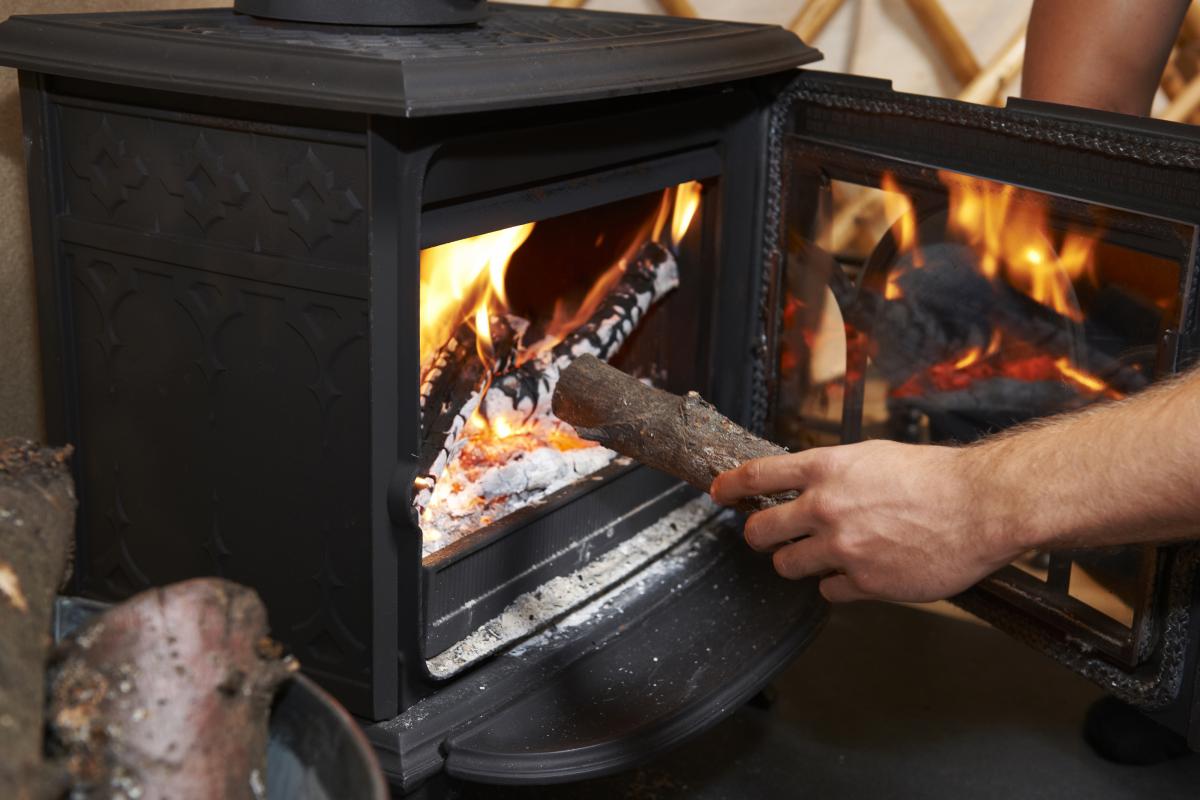Take a deep breath? Investigating indoor air pollution Understand article
New studies are uncovering how emissions from daily household activities pollute the air we breathe at home.
In many towns and cities around the world, air quality is now continually monitored, and laws exist to help keep air pollution to acceptable levels. In some major cities, policies such as banning cars in central zones are helping to reduce the public’s exposure to harmful pollutants. This is, of course, great progress, but when you consider that people in developed countries are estimated to spend around 90% of their time indoors, it is perhaps surprising that our knowledge of indoor air quality lags considerably behind that of outdoor air. In the past few years, however, scientists have started to investigate the quality of indoor air, and the chemistry that creates indoor air pollution, in more detail.
Sources of indoor pollutants

mixture of potentially
harmful gases.
SpeedKingz/Shutterstock.com
The majority of indoor air pollutants originate from things we use and do indoors. This means that the composition of indoor air is usually very different to that of outdoor air. Sources of indoor pollution include gas hobs and wood-burning stoves, which emit a mixture of potentially harmful gases including nitrogen dioxide (NO2) and carbon monoxide (CO). Candles are another significant offender: perhaps surprisingly, burning a candle for just one hour can produce enough NO2 to increase the indoor concentration close to the World Health Organization’s (WHO) limit (hourly mean) of 200 micrograms per cubic metre (µg/m3)w1 (Uhde & Shulz, 2015). These combustion sources also release minute specks of inhalable particles known as particulate matter (PM). At high enough concentrations, NO2 and PM can lead to respiratory and cardiovascular problems, while exposure to high concentrations of CO can be fatal.
Other contributors to indoor pollution are household materials such as paint, vinyl floorings and soft furnishings, as well as personal care products, cleaning agents and air fresheners. These release potentially dangerous volatile organic compounds (VOCs) into the surrounding air. One of the most common VOCs is formaldehyde (methanal, CH2O), a colourless – but smelly – gas that is a respiratory irritant and carcinogen.
Insights into air chemistry
One of the first in-depth studies into indoor air chemistry began in June 2018, when 65 scientists took over a three-bedroom test house in Texas, USA, to begin a project called ‘HOMEChem’w2 (Farmer et al., 2019). Bringing with them $4.5 million worth of equipment, they spent a month cooking, cleaning and performing other everyday tasks, while analytical instruments measured the mixture of indoor chemicals being emitted. The project culminated in the researchers preparing a typical Thanksgiving dinner with roast turkey and all the trimmings. While cooking this meal, NO2 concentrations peaked at approximately 200 µg/m3 as a result of emissions from the gas hob.
But much simpler meals ultimately proved to be a bigger threat: cooking a stir-fry resulted in the highest concentration of PM10 (particles that measure less than 10 µm in diameter) of around 350 µg/m3, as a result of particles from both the cooking oil and the food. To put this in perspective, the WHO limit (24-hour mean) for PM10 is 50 µg/m3. Frying eggs, sausages and tomatoes (in addition to cooking toast for breakfast) produced the highest concentration of fine particles (those measuring less than 2.5 µm in diameter, known as PM2.5) at approximately 200 µg/m3 (Farmer et al., 2019), for which the WHO limit is 25 µg/m3. What’s more, these smaller particles are likely to be more harmful to our health than PM10 , as they can travel further into the respiratory system.

Callie Richmond/Callie Richmond Galleries
Reactions in the air
Once these molecules are released into the air, they don’t hang around in their original form for long. Instead, they can react with other chemicals to form new products. The reaction rates are often different indoors and outdoors. Light-driven reactions, for example, happen more slowly indoors. This is because glass cuts out much of the ultraviolet light that splits molecules apart outdoors. Indoor lights also tend to have low ultraviolet levels. However, these reactions can still happen. For instance, there is sufficient light indoors for formaldehyde to react with oxygen and split to form two hydroperoxy (HO2) radicals and a CO molecule. The HO2 radicals can then form other oxidants that react with the indoor VOCs – and before you know it, there are hundreds of different reactions forming myriad different compounds, some of which are harmful to health.
A more significant driver of indoor reactions, however, is the amount of available surface area. Surfaces play a more important role in indoor chemistry than outdoor chemistry, since the ratios of surface area to volume are much greater indoors than outdoors. This is because the fibres in fleecy surfaces such as carpets and soft furnishings increase the surface area beyond the nominal footprint that such an item occupies in a room. As a result, there are more opportunities for pollutants to settle on surfaces and react with other chemicals deposited there (Weschler & Carslaw, 2018).

project carried out everyday
activities in this three-
bedroom test house in Texas,
USA, to measure indoor air
pollution.
Callie Richmond/Callie
Richmond Galleries
Here, tobacco smoke and e-cigarette vapour are a particular concern. Nicotine and other chemicals in exhaled smoke or vapour linger in the air and stick to surfaces such as those of furniture or fabrics. This residue, which is known as third-hand smokew3, can later react with indoor pollutants such as nitrous acid (HNO2) to form new and often harmful products, such as carcinogenic nitrosamines. Third-hand smoke is currently an area of very active research, given the potentially adverse health effects that arise from exposure to it.
Perhaps the most interesting surface that scientists are exploring, however, is the human body. When ozone in the air comes into contact with the many oils and fatty acids on our skin, they can react to produce a range of secondary pollutants. As we go about our daily indoor lives, we are removing ozone (O3) from the air and releasing other chemicals. For instance, if you use bleach to clean your home, mixing the bleach with water releases chlorine gas (Cl2), hypochlorous acid (HOCl) and other chlorine compounds into the surrounding air. The oils on our skin contain unsaturated compounds with carbon-carbon double bonds, such as squalene (C30H50). The HOCl reacts with the double bonds to form chlorinated compounds, which could explain why our skin becomes irritated without even coming into direct contact with the bleach itself.
Cleaning up pollutants
As a result of these new scientific studies, our once foggy understanding of indoor air pollution is now starting to clear. Evidently, spending so much of our time indoors means that we are exposed to a concoction of chemicals and indoor air pollutants – especially as energy-efficient measures mean that our homes and buildings are increasingly airtight, making it easier for pollutants to build up inside. Minimising our exposure to these pollutants is more important than ever, so remember to ventilate often, especially when you cook and clean, and consider the frequency with which you use air fresheners or scented candles. And judging from the HOMEChem project results, it’s a sensible idea to use a cooker hood whenever you’re using a hob – especially when cooking a breakfast fry-up.
Acknowledgement
The authors acknowledge the support of the Alfred P Sloan Foundationw4 under grant number G-2018-10083 to write this article.
References
- Farmer DK et al. (2019) Overview of HOMEChem: House observations of microbial and environmental chemistry. Environmental Science: Processes and Impacts 21: 1280–1300. doi: 10.1039/c9em00228f
- Uhde E, Shulz N (2015) Impact of room fragrance products on indoor air quality. Atmospheric Environment 106: 492–502. doi: 10.1016/j.atmosenv.2014.11.020
- Weschler CJ, Carslaw N (2018) Indoor chemistry. Environmental Science and Technology 52: 2419–2428. doi: 10.1021/acs.est.7b06387
Web References
- w1 – Visit the website of the World Health Organization (WHO) to read their Guidelines for Indoor Air Quality, published in 2010.
- w2 – Learn more about the ‘HOMEChem’ project in the article ‘Large scale experiment probes chemistry inside our homes’ published in Chemistry World.
- w3 – Watch a short video about third-hand smoke on the ‘Indoor Chem’ YouTube channel.
- w4 – The Chemistry of Indoor Environments webpage on the Sloan Foundation website provides more information about the programme, as well as links to further resources and videos.
Resources
- Read about the health impacts of various air pollutants in a factsheet published by WHO.
- The ‘Indoor Chem’ YouTube channel publishes a range of videos on the topic of indoor air pollution.
Review
While the study of outdoor air pollution and its presence in the media date back many decades, the study of indoor air pollution is a more novel topic. This article, written in a concise and clear style, introduces readers to the complexities of this issue, keeping it as simple as possible without compromising its scientific details.
The article is aimed at secondary school teachers and students, and sparks the readers’ interest with the broader topic of air pollution before addressing theoretical topics in chemistry. The direct link between indoor air pollution and human health offers further teaching opportunities, and the additional web references and resources provide more ways to explore the topic.
The article can also be used as a comprehension exercise, for learning assessments, and for a discussion on the safety of indoor environments and ways of improving air quality through our own habits and behaviours.
Possible comprehension questions include:
- On average, how much time do people in developed countries spend indoors every day?
- Is the composition of indoor air usually similar or different to outdoor air?
- Name two chemicals produced by combustion in gas hobs and wood-burning stoves.
- What is the difference between PM10 and PM2.5? Which type of particle can travel deeper into the lungs?
- Name four household materials that release VOCs.
- Which compounds are produced by the splitting of formaldehyde due to light?
- What is third-hand smoke?
- List three actions that can be taken to reduce indoor air pollution.
- Indoor air pollution is a bigger problem now than it was 50 years ago. Why is this?
Giulia Realdon, natural sciences teacher and education researcher, Italy





